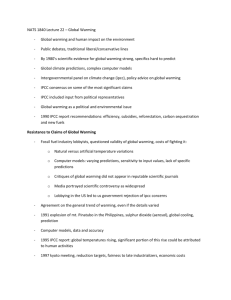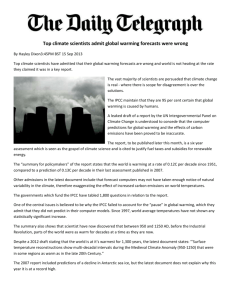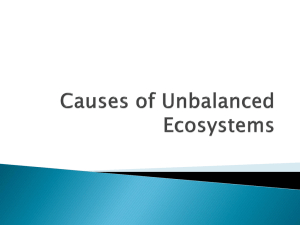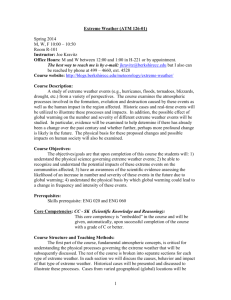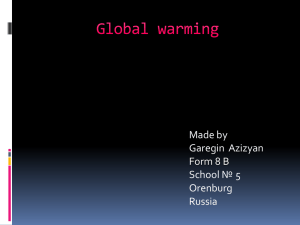2012 Presentation International Conference on Climate Change
advertisement
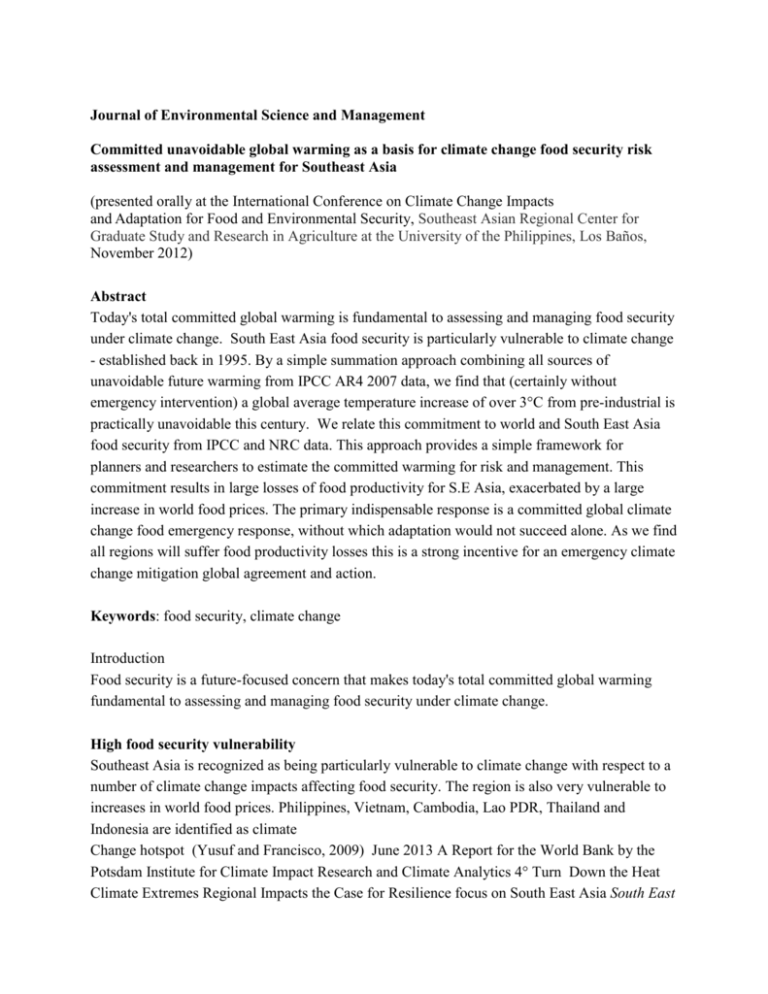
Journal of Environmental Science and Management Committed unavoidable global warming as a basis for climate change food security risk assessment and management for Southeast Asia (presented orally at the International Conference on Climate Change Impacts and Adaptation for Food and Environmental Security, Southeast Asian Regional Center for Graduate Study and Research in Agriculture at the University of the Philippines, Los Baños, November 2012) Abstract Today's total committed global warming is fundamental to assessing and managing food security under climate change. South East Asia food security is particularly vulnerable to climate change - established back in 1995. By a simple summation approach combining all sources of unavoidable future warming from IPCC AR4 2007 data, we find that (certainly without emergency intervention) a global average temperature increase of over 3°C from pre-industrial is practically unavoidable this century. We relate this commitment to world and South East Asia food security from IPCC and NRC data. This approach provides a simple framework for planners and researchers to estimate the committed warming for risk and management. This commitment results in large losses of food productivity for S.E Asia, exacerbated by a large increase in world food prices. The primary indispensable response is a committed global climate change food emergency response, without which adaptation would not succeed alone. As we find all regions will suffer food productivity losses this is a strong incentive for an emergency climate change mitigation global agreement and action. Keywords: food security, climate change Introduction Food security is a future-focused concern that makes today's total committed global warming fundamental to assessing and managing food security under climate change. High food security vulnerability Southeast Asia is recognized as being particularly vulnerable to climate change with respect to a number of climate change impacts affecting food security. The region is also very vulnerable to increases in world food prices. Philippines, Vietnam, Cambodia, Lao PDR, Thailand and Indonesia are identified as climate Change hotspot (Yusuf and Francisco, 2009) June 2013 A Report for the World Bank by the Potsdam Institute for Climate Impact Research and Climate Analytics 4° Turn Down the Heat Climate Extremes Regional Impacts the Case for Resilience focus on South East Asia South East Asia has a high and increasing exposure to slow onset impacts associated with rising sea-level, ocean warming and increasing acidification combined with sudden-onset impacts associated with tropical cyclones and rapidly increasingly heat extremes. When these impacts combine they are likely to have adverse effects on several sectors simultaneously, ultimately undermining coastal livelihoods in the region. The deltaic areas of South East Asia that have relatively high coastal population densities are particularly vulnerable to sea-level rise and the projected increase in tropical cyclones intensity. Adaptation The regions very high vulnerability makes adaptation desirable but probably impossible. Presently there is a great focus on climate change adaptation. It is hardly possible to plan adaptation with no foreseen global temperature stabilization. The high crop yield losses at committed warming are a further barrier to adaptation. Though adaptation has to be attempted, there is no good evidence it will be effective, and without emergency drastic mitigation efforts now, it could not likely succeed. Adaptation responses by growers are also poorly understood and could, in contrast, reduce yield losses. More commonly, adaptations will at best be able to offset 2°C of local warming (Easterling et al., 2007), and they will be less effective in tropical regions where soil moisture, rather than cold temperatures, limits the length of the growing season. NRC 2011 p. 162. An assumption that adaptation will be effective is dangerous as it may compromise the urgent necessity of mitigation. Simple summation of total most policy relevant commitment By a simple summation approach combining all sources of unavoidable future warming, we find that (certainly without drastic planetary emergency intervention) a global average temperature increase of above 3°C from pre-industrial is practically unavoidable this century. oiThe basic climate change commitment is the 2°C 2009 Copenhagen Accord policy agreement, originating with the 1996 EU climate change policy compromise. . Climate science climate change commitment has three definitions in the IPCC AR4 assessment which notes that none of them are the total unavoidable warming. IPCC. 2007a. "Long Term Climate Change and Commitment 10.7." In Working Group 1: The Physical Science Basis, edited by S. Solomon, D. Qin, M. Manning, Z. Chen, M. Marquis, K. B. Averyt, M. Tignor and H. L. Miller. Climate science generally refers to commitment as only the climate system inertia of the ocean heat lag. This results in the full long term eventual equilibrium warming being about double the realized/transient warming, which is the global average temperature increase at the time of atmospheric greenhouse gas concentration stabilization. The IPCC AR4 estimates this is another 0.6°C by 2100 resulting in a commitment today of 1.4°C by 2100. The actual commitment is far greater making the 1.4°C not particularly policy relevant for food security. This and other unavoidable source of warming are: 1. The fastest time taken to atmospheric greenhouse gas concentration stabilization, 2. Ocean heat lag – delayed warming 3. Air pollution aerosol cooling – deferred warming- that will be unmasked with large reductions of fossil fuel combustion (required for atmospheric CO2 stabilization) 4. Carbon feed back (terrestrial and Arctic) incurred warming from the above warming. Today’s warming is 0.8°C 1. Emissions reduction. Emissions reduction takes up a minimum of 0.6°C. The most rapid published emergency emissions reductions to zero carbon contemplated is the 350 ppm Emergency Pathway Greenhouse Development Rights of Ecoequity that takes 40 years to zero carbon emissions. The best case IPCC RCP scenario RCP 2.6 takes 60 years to zero carbon. The most rapid emissions reduction feasible would be 20 years, which is the best case for the online Climate Momentum Simulation by Climate Interactive. The 20 year 95% emissions reduction simulation case results in a warming of 0.6°C to atmospheric CO2 stabilization. 2. Ocean heat lag is 0.6°C to 2100 (IPCC AR4 2007) The multi-model average warming for all radiative forcing agents held constant at year 2000 is about 0.6°C for the period 2090 to 2099 relative to the 1980 to 1999 reference period. IPCC AR4 2007 Working Group I: The Physical Science Basis 10.7 Long Term Climate Change and Commitment. 3. Aerosol cooling The IPCC AR4 2007 range is 0.4°C to 0.8°C We take 0.4°C 4. Carbon feedback Warming so far is 2.4°C. The Terrestrial carbon feedback (no Arctic carbon) is 0.6°C calculated from the IPCC AR4 carbon cycle graph. Our 0.6°C original estimate of terrestrial carbon cycle from IPCC AR4 is very low, as a recent estimate by Booth finds it to be 1.7°C for a similar warming of 2.4°C. Our committed warming is now revised at 3.0°C to 4.0°C, which is in keeping with other assessments of our commitment. Kevin Anderson finds we are committed to 4C without making radical drastic rapid changes (Reframing the climate change challenge in light of post-2000 emission trends. Kevin Anderson and Alice Bows Phil. Trans. R. Soc. A 2008). A November 2012 World Bank Report Turn Down the Heat (part 1) by the Potsdam Climate Impacts Institute finds that without further commitments and action to reduce greenhouse gas emissions, the world is likely to warm by more than 3°C above the preindustrial climate. We apply our original 3°C commitment by 2100 to world S.E Asia food security bearing in mind the world economy has us headed for twice that. World food security is important for S.E.Asia with respect to world food prices under climate change. The commitment is still not complete because the potentially largest commitment remains which is Arctic carbon feedback. The IPCC does not include permafrost or sun Arctic sea floor methane hydrate carbon feedback which could be very large. Policy commitment Even more policy relevant than the climate system science commitment is the policy commitment as this is even higher. An estimate by Climate Interactive of the commitment due to the combined national formal emissions reduction pledges filed with the UN is 4.5°C with a possible upper range of 7.0°C. The November 2012 World Bank report finds that even with the current mitigation commitments and pledges fully implemented, there is roughly a 20 percent likelihood of exceeding 4°C by 2100. If they are not met, a warming of 4°C could occur as early as the 2060s. This only includes a low carbon feedback estimate and the ocean heat lag. The International Energy Agency has been warning for several years that without a strong binding international agreement for large global emissions cuts the world economy has the world headed for a warming of 6.0°C by 2100. On an extension of current trends by 2050, energy use almost doubles (compared with 2009) and greenhouse gas emissions rise even more. The average global temperature rise is projected to be at least 6°C in the long term ( Tracking Clean Energy Progress 2013 IEA) . As the last year (2012) of reported world emissions is an all time record there is no sign of nations acting on emissions reduction pledges and the UN FCCC agenda is for a post 2020 climate regime (UNFCCC The Doha Climate Gateway 2012). This makes a warming of 5°C- 6°C (Climate Interactive business as usual) the realistic policy relevant upper range of our commitment by 2100. Global carbon emissions hit record high in 2012 June 10 (Reuters) - China led a rise in global carbon dioxide emissions to a record high in 2012 … , the International Energy Agency (IEA) said. Worldwide CO2 emissions rose by 1.4 percent to 31.6 billion tonnes, IEA press release June 2012 S. E. Asia climate change vulnerability for food security Today, Southeast Asia is one of the most densely populated areas in the world, with most people living along the coastline. South East Asia is normally affected by climate extremes; floods, droughts and tropical cyclones. South East Asia is classified as extreme risk for climate change vulnerability. In regions where food production is labour intensive climate change impacts on water, food and health are inextricably linked, with losses to one leading to losses of the others. Protecting our Health from Climate Change: a Training Course for Public Health Professionals Chapter 3:Population’s Health and Climate Change in South- East Asia WHO 2008 The SEA region has a large population that is currently vulnerable to a number of climate sensitive health stressors These stressors are already having a significant adverse health impacts in the Region Climate change is likely to increase the risks linked to these stressors, and introduce new sources of risk going forward. Without adaptation and mitigation climate change results in a dramatically increased health burden in the Region. S.E. Asia suffers 44% of all disasters globally 1996-2005, and 57% of people killed globally in natural disasters. Global Warming Impacts on Climate and Risk Factors More extreme weather events: storms, cyclones Heat waves: more frequent, more intense, and longer Air pollution: increase in levels of ground ozone, more allergens floods, and reduced water availability Disturbed rainfall patterns: more droughts, more extreme precipitation events, floods, and disrupted water supply Warmer temperatures: warmer minima Sea-level rise: inundation, saltwater intrusion, loss of land Climate change vulnerability: Index and mapping Harshal T. et al Indian J Occup Environ Med. 2011 Sep-Dec; 15(3): 142–143. doi: 10.4103/0019-5278.93207 South Pacific Applied Geoscience Commission (SOPAC), Climate change vulnerability map of Southeast Asia. Economy and Environment Program for Southeast Asia (EEPSEA); International Development Research Center (IDRC) Climate Change Vulnerability Index (CCVI), released by global risks advisory firm Maplecroft. “extreme risk,” Philippines, Cambodia, Vietnam, Thailand, Samson et al. Strongly negative impacts of climate change are predicted in America, the Arabian Peninsula, Southeast Asia It was clear from the 2007 assessment that for billions of the most climate change vulnerable 1C is the danger limit to comply with the clear intent and specific terms of the 1992 Framework Convention on Climate Change. As it happens, the most climate change vulnerable regions are where the most vulnerable populations live, like such as S E Asia. Warming with respect to S.E. Asia Regional warming is similar to the global mean in Southeast Asia. Climate change: Impacts Vulnerabilities and Adaptation in Developing Countries UN FCCC 2007 p 21 We are at or very close to impact significant summer time warming for S.E Asia. Due to the small temperature variability from one year to another, the earliest emergence of significant warming occurs in the summer season in low latitude countries. A local warming signal that exceeds past variability is emerging at present, or will likely emerge in the next two decades, in many tropical countries. For most countries worldwide, a mean global warming of 1 °C is sufficient for a significant temperature change. Early onset of significant local warming in low latitude countries I Mahlstein 25 Juil;y 2011 http://iopscience.iop.org/1748-9326/6/3/034009/fulltext The World Bank 4C Turn Down the Heat report 2 Southeast Asia is one of two world regions— the other being the Amazon—which is projected to see, in the "near-term," a strong increase in monthly heat extremes. The South East Asian region is projected to see a strong increase in the near term in monthly heat extremes. Under 2°C global warming, heat extremes that are virtually absent at present will cover nearly 60–70 percent of total land area in summer, and unprecedented heat extremes up to 30–40 percent of land area in northern-hemisphere summer. With 4°C global warming, summer months that in today´s climate would be termed unprecedented, would be the new normal, affecting nearly 90 percent of the land area during the northern-hemisphere summer months Sea level rise Sea level is rising due to thermal expansion. It is rising faster than projected. In South East Asia, sea-level rise is projected to be 10–15 percent higher than the global mean. Coupled with storm surges and tropical cyclones, this increase is projected to have devastating impacts on coastal systems ( World Bank Turn Down the Heat 2.) Sea level rise causes loss of arable lands, and salinization of irrigation water (Boer & Dewi 2008, Ho 2008, Jesdapipat, Perez 2008) The World Bank report 2 finds that a sea-level rise of as much as 50 cm by the 2050s may already be unavoidable as a result of past emissions, and in some cases, impacts could be felt much earlier. This will cause greater destruction and result in flooding fields for extended periods, and inundate delta areas with intrusions of salt water into fields and in groundwater used for drinking. The report an estimated sea-level rise of 30 cm (nearly 1 foot) as early as 2040, will cut see crop production drop by about 12 percent to Southeast Asia's major rice-growing region—the Mekong River Delta in Vietnam. Tropical cyclones Warmer surface ocean water is projected to increase the intensity and hence the damage from tropical cyclones. The IPCC AR4 projects a likely increase of peak wind intensities and notably, increased near-storm precipitation in future tropical cyclones. Climate Change 2007: Working Group I: The Physical Science Basis Ch10. 10 ES http://www.ipcc.ch/publications_and_data/ar4/wg1/en/ch10s10-es-13-tropicalcyclones.html World Bank report 2 The intensity and maximum wind speed of tropical cyclones making landfall is projected to increase significantly for South East Asia. Damages may rise as the greatest impacts are caused by the most intense storms. Extreme rainfall associated with tropical cyclones is expected to increase by up to a third reaching 50–80 mm per hour, indicating a higher level of flood risk in susceptible regions. IPCC The 1995 second IPCC assessment recognized S. E. Asia as a region most at risk for hunger and famine due to climate change impacts on regional agricultural production. (CLIMATE CHANGE 1995 Impacts, Adaptations and Mitigation of Climate Change: Scientific-Technical Analyses to the Second Assessment Report of the Intergovernmental Panel on Climate Change 1995 3.3 Food and Fiber p. 9) The figure below is a composite of three IPCC sources - the impacts chart, IPCC AR4 crop model projections recorded on one graph by NRC 2011, and one most important impact of the ‘burning ember’s illustration of the IPCC Five Reasons for Concern which is extreme weather events. Increasing extreme weather is the most damaging climate change impact for both human health and crop productivity. Crop models may be assumed to underestimate crop yield impacts with rising temperatures because a large number of large impacts are not captured by the crop models and the CO2 fertilization benefit is an assumption rather than a robust scientific finding. This was recorded in the third 2001 IPCC assessment (see crop yield results later) and the AR4 2007 IPCC AR4 2007 WG 2 Technical Ch. 5 5.4.2.3 p. 285 Research tasks not yet undertaken – ongoing uncertainties. In terms of experimentation, there is still a lack of knowledge of CO2 and climate responses for many crops other than cereals, including many of importance to the rural poor. Importantly, research on the combined effects of elevated CO2 and climate change on pests, weeds and disease is still insufficient. The true strength of the effect of elevated CO2 on crop yields at field to regional scales, its interactions with higher temperatures and modified precipitation regimes, as well as the CO2 levels beyond which saturation may occur, remain largely unknown. According to NRC Climate Stabilization Targets 2011 P 160162. Processes not included or adequately quantified in climate-crop models are critical thresholds, responses of weeds, responses of insects, responses of pathogens, changes in water resources available for irrigation, increased surface ozone , increased flood frequencies, extremely high temperatures, sustained droughts, year-to-year variability. Other adverse impacts not included in the crop models are soil salinization - sea level, land degradation - soil erosion (NRC 2011) and combined impacts The other thing added to the chart is the additive interactions between the categories of impacts which on the IPCC chart are for climate change only. Source of chart below : R K Pachauri Chairman, IPCC State of the World Symposium Washington 15th January 2009 Low latitude crop yields according to crop model projections start to decline from 0.7 to 1.5°C. All crops decline from 1.6°C. Risk of crop declines Taking the mean of wide ranging model results does not indicate the risk to food security. According to the means of wide ranging crop model projections low latitude crop yields decline from 0.5°C to 1.4°C from preindustrial. Taking the fastest decline crop models considers risk and compensates for the crop model adverse impacts deficiency. In this case crop yields decline from 0.5°C with 20% declines at 2°,C 30% declines at 3°C and 40% declines at 4°C. According to crop model projections all crops in all regions are tipped into decline from 1.5°C. All decline below baseline yields (year 2000) from 2.0°C with the sole exception of IPCC mid-high latitude wheat with assumed high CO2 fertilization benefit. High CO2 benefit is unlikely to materialize due to the many large adverse impacts not captured in these models, e.g. large decline from increasing tropospheric (ground level) ozone. World food output is at risk of decline at a 1.5°C warming, which we are committed to by the ocean heat lag alone. global production potential […] is threatened at +1°C local temperature change…. (1.5°C global) (IPCC, 2007, Figure 5.2 http://www.ipcc.ch/publications_and_data/ar4/wg2/en/ch5s5-4-22.html IPCC food security text. The countries of S.E. Asia are all low latitude, tropics and subtropics. All IPCC assessments from 1995 have shown a loss of crop productivity affecting S.E. Asia The second IPCC Assessment 1995 crop model yield changes give a very wide range. For potential yield losses the results are: rice up to – 22, maize up to – 65%, and wheat up to – 61% Thus the 1995 IPCC assessment showed a huge risk to food security for S. E. Asia. Third IPCC Assessment 2001 Ch. 11 A sia Executive Summary Climate Change 2001: Working Group II: Impacts, Adaptation and Vulnerability Agricultural productivity in Asia is likely to suffer severe losses because of high temperature, severe drought, flood conditions, and soil degradation; food security of many developing countries in the region would be under tremendous threat. There are likely to be large-scale changes in productivity of warmwater and coolwater fish in many countries in Asia. Sea-level rise would cause large-scale inundation along the vast Asian coastline and recession of flat sandy beaches. The monsoons in tropical Asia could become more variable if El Niño-Southern Oscillation (ENSO) events become stronger and more frequent in a warmer atmosphere. Countries in tropical Asia are likely to have increased exposure to extreme events, including forest die-back and increased fire risk, typhoons and tropical storms, floods and landslide, and severe vector-borne diseases. 1.2.1.2. Ensure that Food Production is not Threatened 3.2. Agriculture and Food Security (refers to terms of 1992 UN FCCC) In the tropics and subtropics-where some crops already are near their maximum temperature tolerance and where dryland, nonirrigated agriculture predominates-the literature suggests that yields will tend to decrease with even nominal amounts of climate change. Moreover, the adaptive capacity of less-developed countries in the tropics is limited by financial and technological constraints that are not equally applicable to more temperate, developed countries. For global warming greater than 2.5°C, most studies agree that world food prices-a key indicator of overall agricultural vulnerability-would increase. Much of the literature suggests that productivity increases in middle to high latitudes will diminish, and yield decreases in the tropics and subtropics are expected to be more severe. These projections are likely to be underestimates, and our confidence in them cannot be high because they are based on scenarios in which significant changes in extreme events such as droughts and floods are not fully considered or for which rapid nonlinear climatic changes have not been assumed - vulnerability to extreme events generally is higher than vulnerability to changing mean condition. IPCC 2007 AR4 Working Group 2 5.4.2.2 Review of crop impacts versus incremental temperature change In low-latitude regions, these simulations indicate that even moderate temperature increases 1ºC to 2ºC are likely to have negative yield impacts for major cereal crops. The Asian Development Bank provides a good compilation of the recent research. Observed climate change impacts The fact that climate change has already caused crop damage in the regions makes the situation an emergency because we are committed to several times the 0.8°C warming of today that has led to the damage. The Economics of Climate Change in Southeast Asia: A Regional Review Asia Development Bank 2009 At 0.8°C: there is already a "decline in agricultural production potential in many parts of the region" due to increasing: heat stress, water stress, extreme weather events, floods, climateassociated pests, and climate-associated diseases Observed climate change impacts Heat waves increased (Manton et al 2001 Cruz et al 2006, Tran et al 2005) Intense rains & floods increased (FAO 2000 & 2004, Cruz et al 2008, Tran et al l 2005) Droughts normally associated with El Nino. Severe drought 1997-1998 Indonesia Lao PDR, Philppines, severe episodic localized drought 2004- 2011 (GEO-DRI Drought Monitoring Workshop, May 10-11, 2010, Winnipeg, Manitoba Orn-uma Polpanich Stockholm Environment Institute – Asia) Typhoons (Increased 4.2 times Philippines 1990-2003 (PAGSA) Observed impacts on agriculture are: Increasing temperature- decreased crop yields due to heat stress, Increased livestock deaths due to heat stress, increased outbreak of insect pests and diseases Variability precipitation- increasing frequency drought, floods, and strong tropical cyclones, change in precipitation pattern, crop growing season and sowing period changed, increased runoff and soil erosion Sea level rise- loss of arable lands, salinization of irrigation water (Boer & Dewi 2008, Ho 2008, Jesdapipat, Perez 2008) Increasing Drought and floods As global warming increases some S.E Asia regions are affected by increasingly severe drought and other regions by increasingly severe floods. Some regions may be affected by an increase in both. Addressing Climate Change in Asian and the Pacific Asia Development Bank 2010 Research collected by the Asia Development Bank shows very large losses of crop productivity affecting S.E.Asia at a 3°C committed warming. The ADB report warns of crop yield reductions and price rises over the next 40 years Over the next 40 years Irrigated agriculture in the region is expected to decline in the range of: rice by 14-20%, wheat by 32-44%, maize by 25% and soybean 9-18% Food prices in the region are expected to increase sharply by 2050 compared to those predicted in the absence of climate change, with: rice prices up 29-37%, wheat prices up 81-102%, maize prices up 5897% and soybean prices up 14-49%. Discussion Our total climate science based commitment of 3C by 2100 in keeping with expert estimates and low if anything because we took low estimates of each unavoidable warming source. By policy commitment 3C is unrealistically low. Our crop yield losses are low because of crop models deficient in adverse effects. Conclusion. Without a global climate change food emergency drastic response, global temperatures will increase above 3°C (possibly by 2050 Oxford Climate prediction net èBroad range of 2050 warming from an observationally constrained large climate model ensemble D.J. Rowlands et al Natuire Geoscience March 2012) ) and will be on the way to 6°C by 2100. Projected combined increases in drought ,severe storms, powerful cyclones, floods, coastal inundation, and crop yield declines from climate crop models at a warming of 3C would be catastrophic for S.E. Asia. These changes also lead to large crop production declines affecting the best food producing regions in the Northern hemisphere rending S.E Asia unable to afford food imports on the world market. The first management response is to acknowledge the committed world and regional food decline global climate emergency . Even with a drastic planetary emergency response, the world needs to prepare for catastrophic climate change devastating food availability losses to S.E Asia and many other regions before mid century. Relying on assumed unfounded adaptation benefits without the emergency acknowledgment is simply continuing to abandon the region to climate change devastation as has been the case for well over 15 years. It is impossible to plan effective adaptation in a situation of no foreseen global temperature stabilization.
